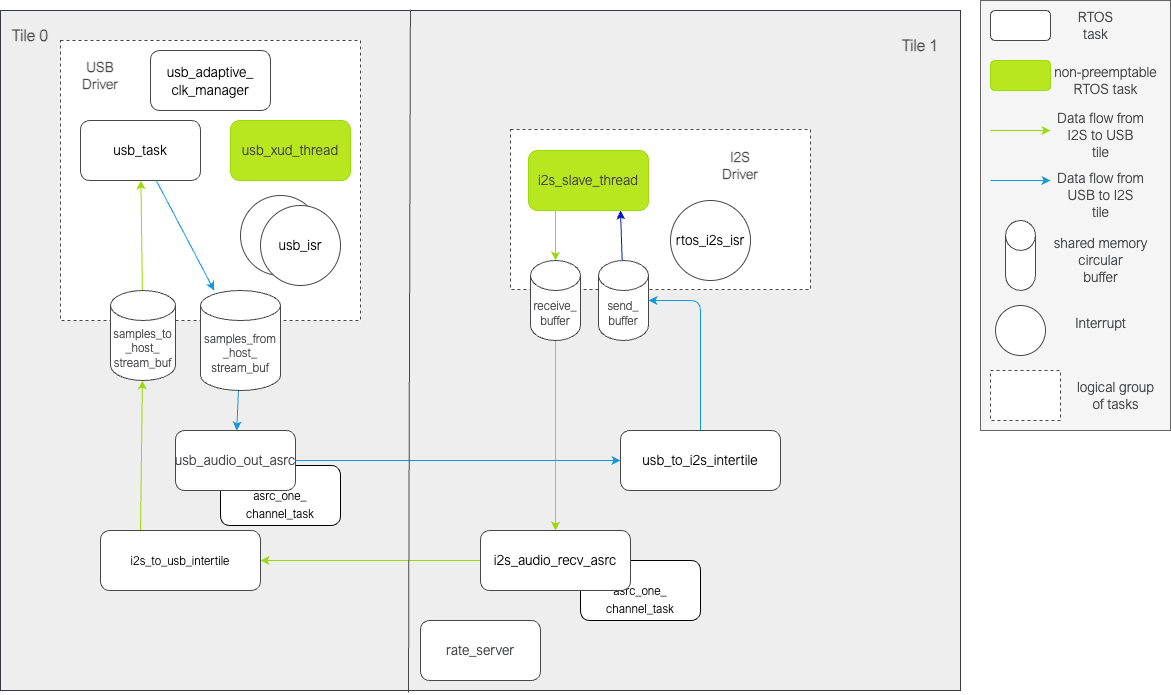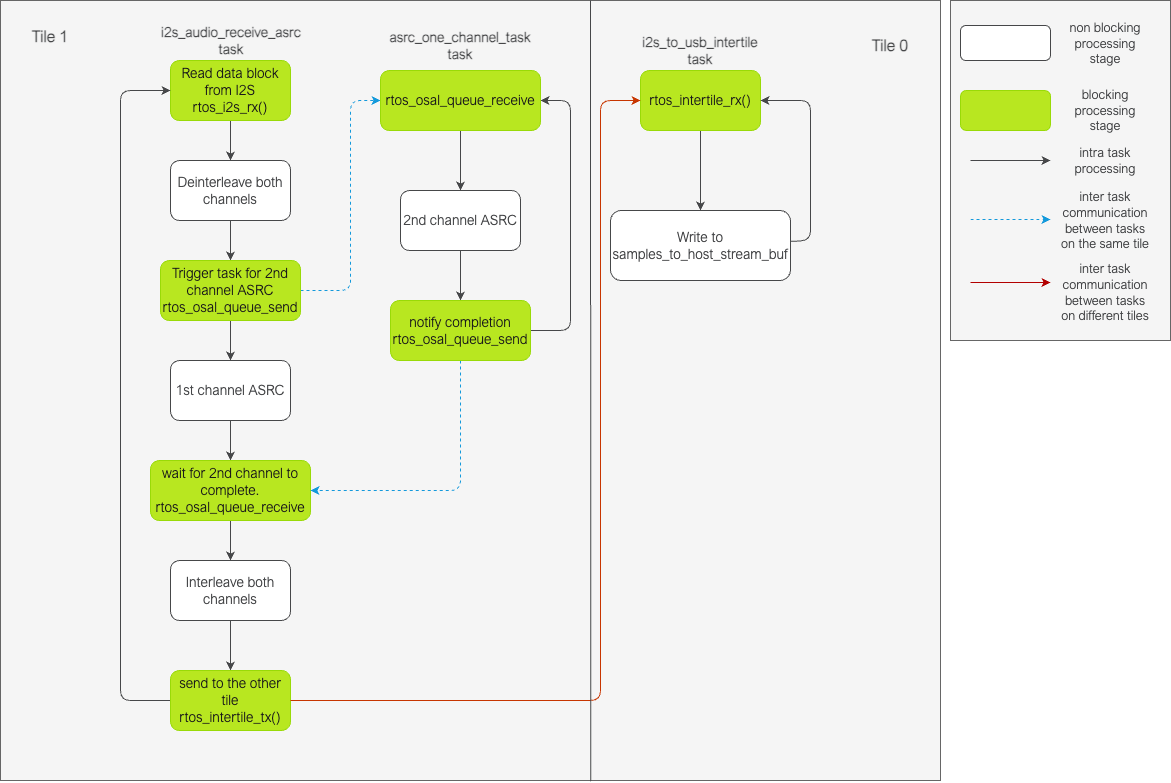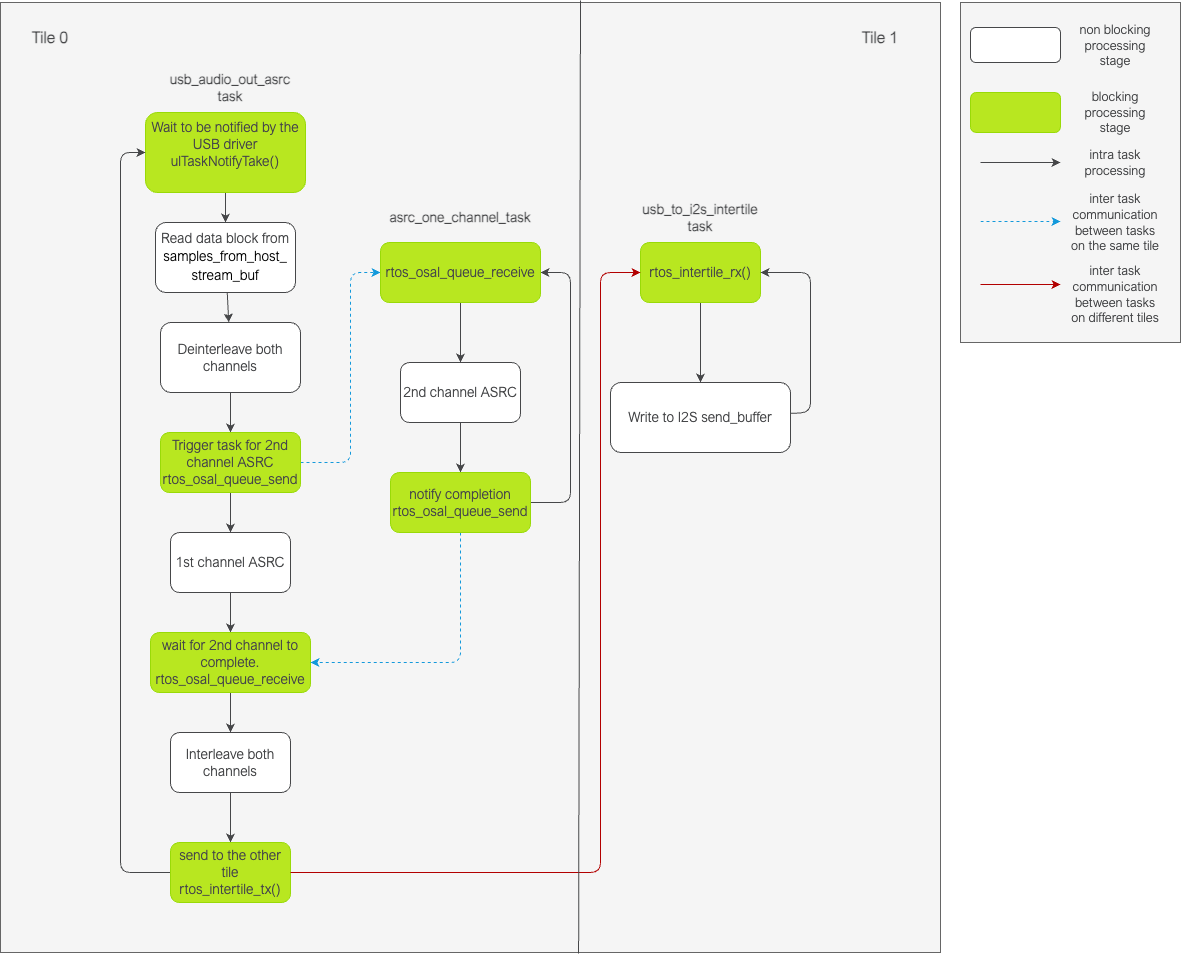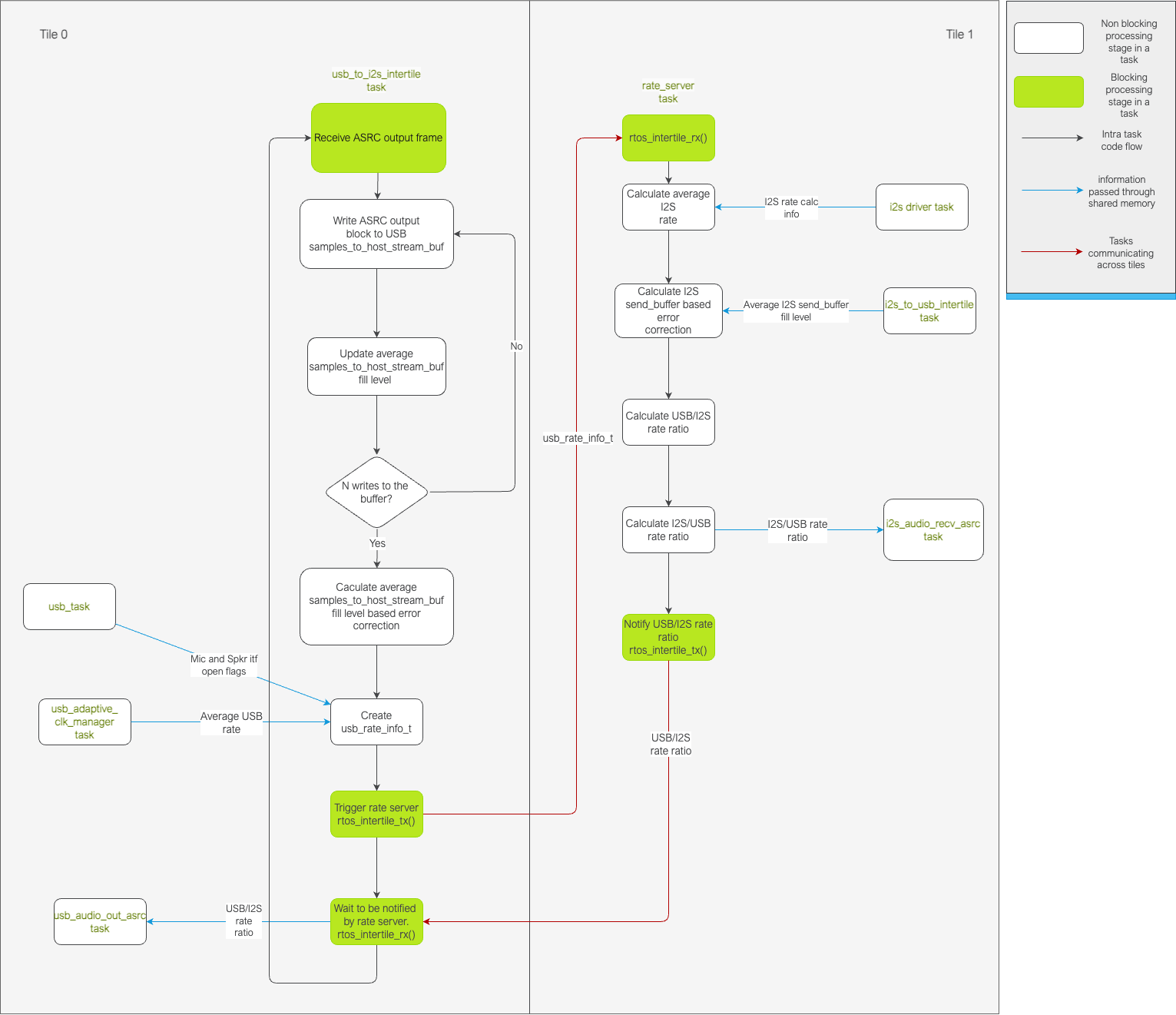Software Architecture#
The ASRC demo application is a two tile application developed to run on the XK-VOICE-L71 board running at a core frequency of 600 MHz.
It is a FreeRTOS based application where all the application blocks are implemented as FreeRTOS tasks.
Each tile has 5 bare metal cores dedicated to running RTOS tasks and since all processing is done within RTOS tasks, each core has 120 MHz of bandwidth available.
Task diagram#
The ASRC example task diagram shows the RTOS tasks and other components that make up the system.

Fig. 11 ASRC example task diagram#
The tasks can roughly be categorised as belonging to the USB driver, I2S driver or the application code categories. The actual ASRC processing happens in four tasks across the two tiles; the usb_audio_out_asrc task, i2s_audio_recv_asrc task, and two instances of asrc_one_channel task, one on each tile. This is described in more detail in the Application components section below.
Most of the tasks are involved in the ASRC processing data path, while a few are involved in monitoring the input and output data rates
and computing the rate ratio, which is the ratio between the frequencies at the input and output of the ASRC tasks.
The rate ratio is provided to the ASRC tasks every asrc_process_frame() call. Details about the rate ratio calculation are described in the rate_server section below.
USB Driver components#
This application presents a stereo, 48 kHz, 32 bit, high-speed, Adaptive UAC2.0 USB interface. It has two endpoints, Endpoint 0 for control and Endpoint 1 for bidirectional isochronous USB audio. The USB application level driver is TinyUSB based.
The usb_xud_thread, usb_isr, usb_task and usb_adaptive_clk_manager implement the USB driver.
Together, these tasks handle the USB communication with the host and also monitor the average USB rate seen by the device.
The average USB rate is used for calculating the rate ratios that are
sent to the asrc_process_frame() function. This is described more in the rate_server section.
The usb_xud_thread runs XUD_Main which implements the USB HIL driver. It runs on a dedicated bare metal core so cannot be preempted by other RTOS tasks.
It interfaces with the USB app level thread (usb_task) via shared memory and dedicated channels between the XUD_Main and each endpoint.
XUD_Main notifies the connected endpoint of a USB transfer completion through an interrupt on the respective channel. This interrupt is serviced by the usb_isr routine.
usb_task implements the app level USB driver functionality. The app level USB driver is based on TinyUSB which hooks into the application by means of callback functions.
The usb_isr task is triggered by the interrupt and parses the data transferred from XUD and places it on a queue that the usb_task blocks on for further processing.
For example, on completion of an EP1 OUT transfer, the transfer completion gets notified on the usb_xud_thread -> usb_isr -> usb_task path,
and the usb_task calls the tud_audio_rx_done_post_read_cb() function to have the application process the data received from the host.
On completion of an EP1 IN transfer, the transfer completion again follows the usb_xud_thread -> usb_isr -> usb_task path, and usb_task calls the tud_audio_tx_done_pre_load_cb()
callback function to have the application load the EP1 IN data for the next transfer.
samples_to_host_stream_buf and samples_from_host_stream_buf are circular buffers shared between the application and the USB driver and allow for decoupling one from the other.
The data frame received over USB from the host is written to the samples_from_host_stream_buf by the TinyUSB callback function tud_audio_rx_done_post_read_cb(),
while the application reads USB_TO_I2S_ASRC_BLOCK_LENGTH samples of data out of it.
Similarly, the application writes the ASRC output block of data to the samples_to_host_stream_buf while the TinyUSB callback function tud_audio_tx_done_pre_load_cb()
reads from it to send one frame of data to the USB host.
usb_adaptive_clk_manager task is responsible for calculating the average USB rate as seen by the device. The average rate is calculated over a 16-second moving window. The averaging smooths out any jitter seen in the USB SOF timestamps that are used for calculating the rate.
I2S Driver components#
This application presents a stereo 32 bit, I2S Slave interface that supports I2S sampling rates of 44.1, 48, 88.2, 96, 176.4 and 192 kHz. The I2S driver supports tracking dynamic sampling rate (SR) changes and recalculates the nominal sampling rate after detecting a SR change event. It also continuously monitors the timespan over which a fixed number of samples are received. This information is then used by the application for calculating the average I2S rate seen by the device.
i2s_slave_thread, I2S send_buffer and receive_buffer and rtos_i2s_isr make up the I2S driver components.
i2s_slave_thread implements the I2S HIL driver. The HIL level driver calls into the application callback functions for i2s_init(), i2s_restart_check(), i2s_receive() and i2s_send().
These functions, in addition to handling I2S send and receive data, also detect sampling rate changes and gather information for tracking the average sampling rate.
I2S send_buffer and receive_buffer are circular buffers shared between the driver and the application and contain data received over I2S (receive_buffer) and data the application wants to send over I2S (send_buffer).
These buffers allow for decoupling the I2S HIL driver from the ASRC application. The driver reads from and writes to these buffers at the I2S sample rate while the application can read and write blocks of data to these buffers equal to the ASRC input or output block size.
The application calls rtos_i2s_rx() to read I2S_TO_USB_ASRC_BLOCK_LENGTH samples of data from the receive_buffer. The i2s_slave_thread independently calls i2s_receive() callback function to write a sample of data as it gets received over I2S.
Similarly, the application calls rtos_i2s_tx() to write ASRC output size block of data into the send_buffer. Meanwhile, the driver independently calls the callback function i2s_send() to read a sample of data to send over the I2S.
rtos_i2s_isr interrupt is used to ensure that the application calls to rtos_i2s_rx() and rtos_i2s_tx() block only on RTOS primitives when waiting for read data to be available or buffer space to be available when writing data.
Application components#
usb_audio_out_asrc, i2s_audio_recv_asrc, asrc_one_channel_task, usb_to_i2s_intertile, i2s_to_usb_intertile and the rate_server tasks make up the non-driver components of the application.
usb_audio_out_asrc performs ASRC on data received from the USB host to the device. It waits to get notified by the TinyUSB callback function tud_audio_rx_done_post_read_cb() when there are one or more ASRC input blocks (96 USB samples) of data in the samples_from_host_stream_buf.
It does ASRC processing of the first channel while coordinating with the asrc_one_channel_task for processing the second channel in parallel and sends the processed output to the other tile on the inter-tile context.
i2s_audio_recv_asrc performs ASRC on data received over the I2S interface by the device. It blocks on the rtos_i2s_rx() function to receive one ASRC input block (244 I2S samples) of data from I2S and performs ASRC on one channel
while coordinating with the asrc_one_channel_task for processing the second channel in parallel. It then sends the processed output to the other tile on the inter-tile context.
asrc_one_channel_task performs ASRC on a single channel of data. There is one of these on each tile. It waits on an RTOS message queue for an ASRC input block to be available, does ASRC processing on the block and posts the completion notification on another message queue.
usb_to_i2s_intertile task receives the ASRC output data generated by usb_audio_out_asrc over the inter-tile context onto the I2S tile and writes it to the I2S send_buffer.
It has other rate-monitoring related responsibilities that are described in the rate_server section.
i2s_to_usb_intertile task receives the ASRC output data generated by i2s_audio_recv_asrc over the inter-tile context onto the USB tile and writes it to the USB samples_to_host_stream_buf.
It has other rate-monitoring related responsibilities that are described in the rate_server section.
The I2S -> ASRC -> USB data path diagram shows the application tasks involved in the I2S -> ASRC -> USB path processing and their interaction with each other.

Fig. 12 I2S -> ASRC -> USB data path#
The USB -> ASRC -> I2S data path diagram shows the application tasks involved in the USB -> ASRC -> I2S path processing and their interaction with each other.

Fig. 13 USB -> ASRC -> I2S data path#
rate_server#
The ASRC process_frame API requires the caller to calculate and send the instantaneous ratio between the ASRC input and output rate. The rate_server is responsible for calculating these rate ratios for both USB -> ASRC -> I2S and I2S -> ASRC -> USB directions.
Additionally, the application also monitors the average buffer fill levels of the buffers holding ASRC output to prevent any overflows or underflows of the respective buffer. A gradual drift in the buffer fill level indicates that the rate ratio is being under or over calculated by the rate_server. This could happen either due to jitter in the actual rates or precision limitations when calculating the rates.
The average fill level of the buffer is monitored and a closed-loop error correction factor is calculated to keep the buffer level at an expected stable level.
The error estimated based on the buffer fill level is used to compute the estimated rate ratio from the initial rate ratio. This estimated rate ratio is then sent to the ASRC process_frame() API.
estimated_rate_ratio = initial_rate_ratio + buffer_based_correction_factor
The rate_server runs on the I2S tile (tile 1) and is periodically triggered from the USB tile (tile 0) by the usb_to_i2s_intertile task. The rate_server is triggered once after every 16 frames are written to the samples_to_host_stream_buf.
The following information is needed for calculating the rate ratios:
The average I2S rate
The average USB rate
An error factor computed based on the USB
samples_to_host_stream_buffill levelAn error factor computed based on the I2S
send bufferfill levelA USB
mic_interface_openflag indicating if the USB host is streaming out from the device, since the rate ratio in the I2S -> ASRC -> USB direction is calculated only when the host is reading data from the deviceA USB
spkr_interface_openflag indicating if the USB host is streaming into the device, since the rate ratio in the USB -> ASRC -> I2S direction is calculated only when the host is sending data to the device
Of the above, the USB related information (2, 3, 5 and 6 above) is available on the USB tile. When triggering the rate_server, the i2s_to_usb_intertile task gets this information, either calculating it or getting it through shared memory from other USB tasks on the same tile, and sends it to the rate_server over the inter-tile context using the structure below.
typedef struct
{
int64_t buffer_based_correction;
float_s32_t usb_data_rate;
bool mic_itf_open;
bool spkr_itf_open;
}usb_rate_info_t;
The I2S related information (1 and 4 above) is calculated in the rate_server itself with information available for calculating these available through shared memory from other tasks on this tile.
After calculating the rates, the rate_server sends the rate ratio for the USB -> ASRC -> I2S side to the usb_to_i2s_intertile task over the inter-tile context and it is made available to the usb_audio_out_asrc task through shared memory. The I2S -> ASRC -> USB side rate ratio is also made available to the i2s_audio_recv_asrc task through shared memory since it runs on the same tile as the rate server.
The Rate calculation code flow diagram shows the code flow during the rate ratio calculation process, focussing on the usb_to_intertile task that triggers the rate_server and the rate_server task where the rate ratios are calculated.

Fig. 14 Rate calculation code flow#
Handling I2S sampling rate change events#
The I2S driver monitors the I2S nominal rate and provides this information to the application. When an I2S sampling rate change happens:
The ASRC instances on both tiles are re-initialised with the new sampling rate.
The buffers that are used for buffer-fill-level based correction are reset. Streaming out of them is paused while zeroes are sent out over both USB and I2S. Once the buffers fill to a stable level, streaming out from them resumes.
The average buffer level calculation state is reset and the average buffer level calculation starts afresh. New stable buffer levels are also calculated and the buffer levels are now corrected against these new stable averages.
Note that the device starts with the nominal I2S sampling rate set to zero. Device startup therefore follows the same path as an I2S sampling rate change where the sampling rate goes from zero to first detected nominal sampling rate. Everything described above therefore also applies to the device startup behaviour.
Handling USB speaker interface close -> open events#
When the USB host stops streaming to the device and then starts again, this event is detected through calls to the tud_audio_set_itf_close_EP_cb and tud_audio_set_itf_cb functions.
The ASRC output buffer in the USB -> ASRC -> I2S path (I2S send_buffer) is reset.
Zeroes are then sent over I2S until the buffer fills to a stable level, when we resume streaming out of this buffer to send samples over I2S.
The average buffer calculation state for the I2S send_buffer is also reset and a new stable average is calculated against which the average buffer levels are corrected.
Handling USB mic interface close -> open events#
If the USB host stops streaming from the device and then starts again, this event is detected through calls to the tud_audio_set_itf_close_EP_cb and tud_audio_set_itf_cb functions.
The ASRC output buffer in the I2S -> ASRC -> USB is reset (USB samples_to_host_stream_buf).
Zeroes are streamed to the host until the buffer fills to a stable level, when we resume streaming out of this buffer to send samples over USB.
The average buffer calculation state for the USB samples_to_host_stream_buf is also reset and a new stable average is calculated against which the average buffer levels are corrected.